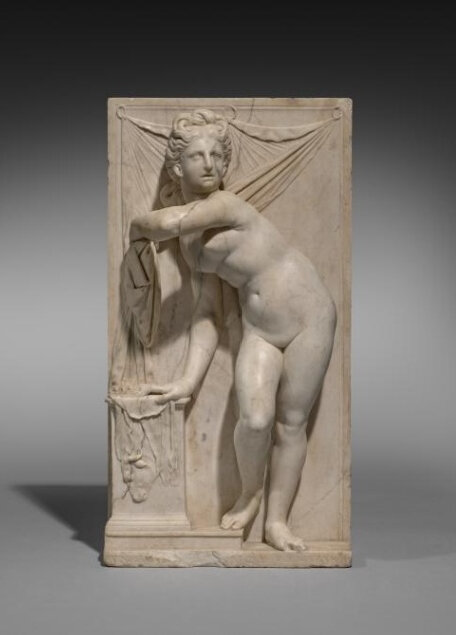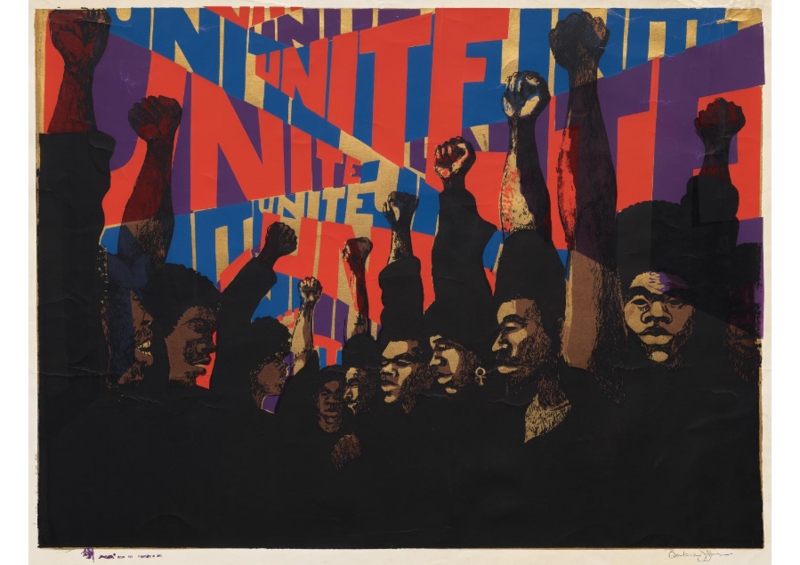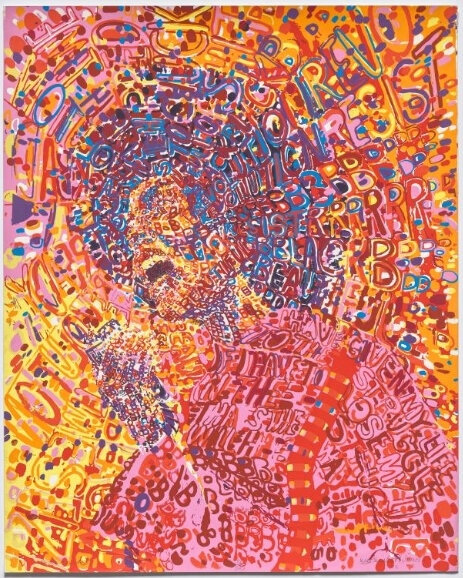The Cleveland Museum of Art announces new acquisitions
CLEVELAND, OH.- Recent acquisitions by the Cleveland Museum of Art include Aurelio Lombardo’s Dido, an exquisitely carved early 16th-century marble relief sculpture; a drawing by Giulio Romano directly related to one of the artist’s most important frescoed ceilings in Italy; Gustave Caillebotte’s Study of a Man with Hands in His Pockets, a rare drawing by the Impressionist master that greatly enhances the museum’s collection of 19th-century French art.
Additional recent acquisitions continue to expand the CMA’s representation of works by African American artists and other artists of color, including four screenprints by Barbara Jones-Hogu, Wadsworth Jarrell, and Amy Sherald, and four photographs by D’Angelo Lovell Williams. Zilia Sánchez’s Troyanas (de la serie Módulos Infinitos) [Trojans (of the Infinite Module series)], an impressively scaled modular painting, adds to the museum’s contemporary holdings of Latin American art.
Dido, c. 1525. Aurelio Lombardo (Italian, 1501-1563). Marble; overall: 51.7 x 49.8 x 8.5 cm. The Cleveland Museum of Art, Mr. and Mrs. William H. Marlatt Fund, 2021.2.
Dido. The CMA acquires Mannerist sculpture at auction from the celebrated collection of Hester Diamond
On January 29, 2021, the CMA acquired Aurelio Lombardo’s sculpture Dido from the auction of Hester Diamond’s collection at Sotheby’s, New York. Created at a pivotal moment in the birth of Mannerist sculpture, it depicts the legendary queen Dido. Departing from the customary portrayal of Dido as a forlorn lover abandoned by the Trojan hero Aeneas, Aurelio’s Dido is active and defiant. The sculpture’s inscription identifies her as the queen of Carthage, and she is represented pulling aside an oxhide curtain, a reference to Virgil’s description of the mythical founding of Carthage in his epic poem, the Aeneid.
Dido is depicted nude and her wavy hair is worn in loose knots, an allusion to Hellenistic images of Aphrodite. Lombardo’s virtuoso carving ranges from the delicate, low relief of the oxhide-draped altar, to an elbow and knee that break free from the marble surface. Dido’s parted lips and striking, articulated pupils convey intense emotion. The softness of her flesh is contrasted with the taut folds of draped and stretched animal skin.
Dido is among a handful of marble sculptures attributed to the artist and was likely created for display in a studiolo, a place of study featuring refined works of art appreciated by humanist scholars and aficionados during the Renaissance. Ancient Greek and Roman works of art were most coveted, but reliefs such as Dido, created in the stylistic language of ancient sculpture and illustrating key figures from ancient texts, were highly sought after, particularly in northern Italy.
Dido exemplifies a vital transition in Italian sculpture from Renaissance clarity to the Mannerist play of proportion and movement. It represents the highest degree of sophistication and innovation of an art form rarely encountered on the market.
The CMA’s strong collection of classically inspired Renaissance busts of great men by Mino da Fiesole, Girolamo della Robbia and Gregorio di Lorenzo provides the historical context in which Lombardo’s commanding sculpture introduces a provocative note of feminine challenge.
The CMA acquires two important, rare drawings: Justice and Study of a Man with Hands in His Pockets
Justice, 1530-34. Giulio Romano (Italian, 1492/99-1546). Pen and brown ink and wash within brown ink and red chalk framing lines; sheet: 18 x 9.8 cm. The Cleveland Museum of Art, Mr. and Mrs. William H. Marlatt Fund, 2021.1.
The CMA has acquired two important drawings: a figure study by Giulio Romano that is one of eight surviving preparatory studies for a frescoed ceiling at the Palazzo del Te in Italy, and a rare study by Impressionist Gustave Caillebotte.
Italian painter Giulio Pippi, called Giulio Romano, is first recorded as a student of Raphael in Rome during his work on the papal apartments and is among the most celebrated of the highly talented pupils surrounding the master. His art was grounded in the emulation of antique forms, and his contemporaries praised him for his ability to spontaneously execute variations on antique motifs through drawing.
Justice is a preparatory drawing relating directly to one of Giulio’s most important frescoed ceilings at the Palazzo del Te at Mantua, that of the vaulted Camera di Attilio Regolo (Atilius Regulus) painted between 1530 and 1534. The four main spandrels of the vault are decorated with scenes that represent moral virtue exemplified by four ancient military rulers, while a tribute to the Duke of Mantua, the Allegory of the Virtues of Federico Gonzaga, adorns the center of the ceiling. Justice is the design for one of four single figures representing virtues placed between the narrative scenes. The drawing dates from the 1530s, when Giulio worked primarily in pen and ink with added wash for shadow. The elegant figure is turned to one side in an active pose with fluttering dress and hair; she holds a balance in her left hand and sword in her right.
This is the second drawing by Giulio to enter the CMA collection in recent years. In 2020, the museum acquired Design for a Frieze with a Putto and Acanthus Leaves (2020.70), perhaps a design for an ornamental rinceau (doorway surround) dated to 1520.
Gustave Caillebotte is well known as a central member of the Impressionist circle; he participated regularly in their group exhibitions from 1874 through 1886. His drawing Study of a Man with Hands in His Pockets depicts Caillebotte’s close friend Eugène Lamy wearing a bourgeois suit and hat, standing in a casual pose and facing away from the viewer. With sketchy, diagonal marks, the artist recorded light and shadow on the man’s jacket, aligning with the Impressionists’ interest in capturing natural effects and fleeting moments from everyday life.
The imagery of a single man seen from behind is among Caillebotte’s most representative and personally significant subjects, because it rejected the formality of Salon painting and instead embraced the spontaneity of Impressionism. Although Study of a Man features an image that was frequently used throughout Caillebotte’s oeuvre, as a drawing it is rare. The artist produced a relatively small number of known drawings and, of those, few are of comparable finish to the CMA’s work.
Study of a Man enhances the transformative gift of works from the collection of Joseph P. and Nancy F. Keithley, which brings two paintings by Caillebotte as a gift and promised gift to the collection, Villas at Trouville (2020.105) and Chickens, Game Birds, and Hares (10.2020) in addition to Portrait of a Man (2009.157), acquired by the museum in 2009. Study of a Man solidifies Cleveland’s place as one of the most important repositories of Caillebotte’s work in the world and of 19th-century French art in the United States today. It will be featured prominently in a forthcoming exhibition and publication on Cleveland’s holdings of 19th-century French drawings, organized by Associate Curator of Prints and Drawings Britany Salsbury, with the support of major grants from the Getty Foundation’s Paper Project Initiative and the Wolfgang Ratjen Foundation.
Four color screenprints by African American artists Barbara Jones-Hogu, Wadsworth Jarrell, and Amy Sherald contribute to the CMA’s mission to diversify its collections: Unite; Untitled (Land Where My Father Died); Revolutionary; and Handsome
Barbara Jones-Hogu and Wadsworth Jarrell were founding members of AfriCOBRA (African Commune of Bad Relevant Artists), a Chicago-based collective founded in 1969 to forge a distinctly Black mode of contemporary art. The group aligned themselves with the Black Power movement of the period and drew inspiration from African art and culture with the goal of promoting racial pride and greater social equity. The artists belonging to AfriCOBRA favored printmaking, which they saw as a fundamentally democratic means to share their message.
Barbara Jones-Hogu’s Unite is among the group’s most recognizable images. The screenprint features a crowd of figures with fists raised in the Black Power salute with their hair styled in Afros to signify Black pride. Jones-Hogu was inspired by two Black athletes who raised their fists during the 1969 Olympics, and she recognized the potential of the powerful gesture to unify. Unite became one of AfriCOBRA’s most iconic images and ultimately Jones-Hogu’s most famous work of art. The CMA has acquired Unite as well as Untitled (Land Where My Father Died), an earlier screenprint by Jones-Hogu that referenced protests taking place on Chicago’s historically Black south side at the time of the Civil Rights Movement.
Wadsworth Jarrell’s screenprint Revolutionary is considered among the most important images associated with AfriCOBRA’s printmaking output and one of the artist’s most iconic compositions. Revolutionary reinterprets a 1971 painting (now at the Brooklyn Museum) depicting activist Angela Davis, based on a widely circulated photograph of her delivering a speech in 1970. Davis is represented in the artist’s signature vibrant palette surrounded by words that she used in her speech, such as “revolution,” “black is beautiful,” and “resist.” The monumentality of the print, in which Davis’s figure dominates the composition, demonstrated Jarrell’s desire to “capture the majestic charm, seriousness, and leadership of an astute drum major for freedom.”
Revolutionary, 1972, Wadsworth Jarrell (American, b. 1929). Color screenprint on off-white heavy wove paper; image: 83.9 x 67.4 cm (33 1/16 x 26 9/16 in.); Sheet: 83.9 x 67.4 cm (33 1/16 x 26 9/16 in.), Karl B. Goldfield Trust 2021.15.
Amy Sherald is known for her distinctive style of portraiture, which she uses to explore the African American experience. Her portraits depict Black figures, often wearing bright or distinctive clothing, but with their skin tone rendered in grisaille. The absence of color invites the viewer to consider identity and color as signifiers, and the direct, assertive, and neutral gazes of her sitters encourage them to be seen as individuals. Sherald’s first print, Handsome, reinterprets a 2019 painting of the same title that depicts Jamar Roberts, a dancer for the Alvin Ailey American Dance Theater, formed in 1958 to combine modern dance with Black culture. Handsome will be featured in an upcoming exhibition at the CMA scheduled for spring 2022, Women Now, that focuses on contemporary women printmakers.
Handsome, 2020, Amy Sherald (American, b. 1973). Color screenprint; image: 102.2 x 81.3 cm (40 1/4 x 32 in.); Sheet: 114.9 x 94 cm (45 1/4 x 37 in.). Gift of The Print Club of Cleveland 2020.277.
Four photographs by D’Angelo Lovell Williams enrich diversity of the CMA’s collection of photographs
In four photographs—Mama’s Always Watching; Was Blind But Now I See (Granny); Hieroglyph 1; and Take My Hand—D’Angelo Lovell Williams poses himself, his family, and a lover in meticulously staged photos that explore what the artist describes as “intersections of blackness, queerness, and family.” A central theme in Lovell Williams’s work is touch—black flesh meeting black flesh. The four photographs reveal touch between lovers and generations of family members. His suggested narratives are multilayered, specifically referring to race and sexuality, while being simultaneously universal, exploring issues of human vulnerability and intimacy.
Modernist painting adds to the museum’s international holdings of art by Latin American, women, and LGBTQ artists: Troyanas (de la serie Módulos Infinitos) [Trojan Women (of the Infinite Module series)], 1964/1993.
Troyanas (de la serie Módulos Infinitos) (Trojan Women [of the Infinite Module series]), 1964/1993, part of a set, Zilia Sánchez (Cuban, b. 1926). Acrylic on canvas; overall: 91.4 x 137.2 cm (36 x 54 in.), Dorothea Wright Hamilton Fund 2020.262.
Cuban-born Zilia Sánchez (b. 1926) is an intriguing yet underrepresented Latin American modernist artist. Troyanas, from her Infinite Module series, is an impressively scaled, modular painting comprising three striking, shaped panels. It is exemplary of the bulbous, curved canvases, suggestive of the body, that have become emblematic of Sánchez’s signature style. Throughout her career, Sánchez has been inspired by female warriors, and the title Troyanas (Trojan Women) invokes the legendary women of Troy and their inner strength while mourning the loss of their land. The serial panels evoke lines of female warriors standing together united, highlighting the collective power of women. The bold black and white palette accentuates the canvas’s shaped forms.The 1960s was a key historical period in Latin American modernism and this work fills an important gap in the collection. With this acquisition, Troyanas allows the museum to tell a more global story of art and abstraction. Troyanas will be on view in the reinstallation of the CMA’s contemporary galleries, reopening to visitors in April 2021.

/https%3A%2F%2Fprofilepics.canalblog.com%2Fprofilepics%2F1%2F0%2F100183.jpg)
/https%3A%2F%2Fstorage.canalblog.com%2F03%2F02%2F119589%2F96711876_o.jpg)
/https%3A%2F%2Fstorage.canalblog.com%2F11%2F31%2F119589%2F94773502_o.jpg)
/https%3A%2F%2Fstorage.canalblog.com%2F20%2F83%2F119589%2F94772815_o.jpg)
/https%3A%2F%2Fstorage.canalblog.com%2F26%2F72%2F119589%2F75604929_o.jpg)
/https%3A%2F%2Fstorage.canalblog.com%2F59%2F60%2F119589%2F26458628_o.jpg)









/http%3A%2F%2Fstorage.canalblog.com%2F27%2F73%2F119589%2F129829910_o.jpg)
/http%3A%2F%2Fstorage.canalblog.com%2F48%2F07%2F119589%2F32580676_o.jpg)
/http%3A%2F%2Fstorage.canalblog.com%2F68%2F72%2F119589%2F129601013_o.jpg)
/http%3A%2F%2Fstorage.canalblog.com%2F17%2F87%2F119589%2F122324247_o.png)